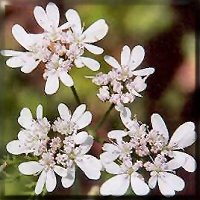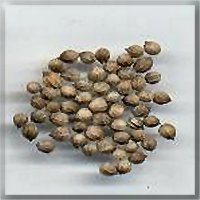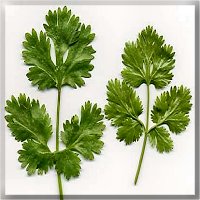


Coriandrum sativum



Coriandrum sativum
Synonyms - Chinese Parsley, Chinese-parsley, Cilantrico, Cilantro, Coriander, Coriandrum, Culantrico, Culantro, Dhanya, Hsiang Sui, Hu Sui, Katumber, Ketumbar, Kisnis, Koendoro, Koriander, Kozahla, Kuzbarah, Misima-Saiko, Penjilang, Yuan Sui
Origin - Eastern Mediterranean or Asia Minor.Description - Coriander as a spice comes from the seeds while Cilantro comes from the leaves of the same plant and is considered an herb. The coriander grown in Russia and Central Europe (var. microcarpum) has smaller fruits and contains more essential oil than the oriental variety var. vulgare, which is cultivated for fruits and leaves. Coriander is a rigid, strong-smelling annual with a pronounced taproot, and slender branching stems up to 60 cm. Reaching a height of 1 meter, the adromonoecious plant flowers in July and August. The plant has ferny, pinnately or ternately decompound leaves and produces compound umbels with small white or pinkish flowers that are attractive to bees. Seed capsules are round red-brown and aromatic when ripe.
Medicinal use - Coriander has been used as an antispasmodic, carminative, stimulant, and stomachic. Coriander has also exhibited hypoglycemic activity. Chinese herbal medicine includes the use of coriander for measles, stomachache, nausea, hernia, and as a tonic. Coriander seed oil has antibacterial properties and is used for treating colic, neuralgia and rheumatism. The oil also counteracts unpleasant odours in pharmaceutical preparations and tobacco. It is used in perfumes, liqueurs and gin. Seeds are sometimes used as a flavoring agent to improve taste in other medicinal preparations. The seeds are ground into a paste for application to skin and mouth ulcers.
Pharmacology - In the ripe fruits, the content of essential oil is comparably low (typically, less than 1%); the oil consists mainly of linalool (50 to 60%) and about 20% terpenes (pinenes, γ-terpinene, myrcene, camphene, phellandrenes, α-terpinene, limonene, cymene). In toasted coriander fruits, pyrazines are formed as the main flavour compounds (see cumin). The taste of the fresh herb is due to an essential oil (0.1%) that is almost entirely made up of aliphatic aldehydes with 10 to 16 carbon atoms. One finds both saturated (decanal) and α,β unsaturated (trans-2-tridecenal) aldehydes; the same aldehydes appear in the unripe fruits. Similar compounds occur in a few other spices and herbs, all of which share coriander's flavour: Examples include long coriander, Vietnamese coriander and the Japanese chemotype of chameleon plant.
Contra-indications - Handling the leaves of coriander or from coming in contact with the oil over a long period of time may result in dermititis from the seeds.